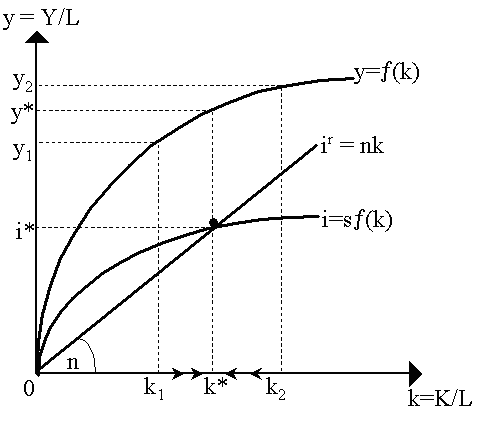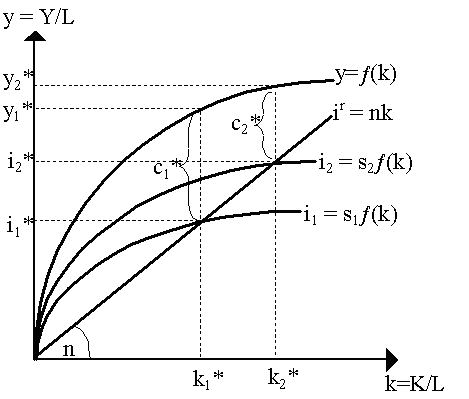|
Contents (1) Absolute Convergence We should touch upon the convergence hypotheses of the Solow-Swan growth model, given that it has generated much empirical speculation in recent years. There are two versions of this. the absolute convergence and the conditional convergence hypotheses. (1) Absolute Convergence The absolute convergence hypothesis, posits the following: consider a group of countries, all of which have have access to the same technology (¦ (·)), the same population growth rate (n) and the same savings propensity (s), and only differ in terms of their initial capital-labor ratio, k. Then, we should expect all countries to converge to the same steady-state capital-labor ratio, output per capita and consumption per capita ( k*, y*, c*) and, of course, the same growth rate (n). Absolute convergence is depicted in Figure 1, where we can assume that k1 represents the capital-labor ratio of a poor country and k2 the capital-labor ratio of a rich country. As they are otherwise identical, the stability of the Solow-Swan model predicts that both the poor and rich countries will approach the same k*. Notice that this means that the poor country will grow relatively fast (capital and output grow faster than n), while the rich nation will grow quite slowly (capital and output grow slower than n). Stated differently in adjustment terms, as k1 < k2, then ¦ ¢ (k1) > ¦ ¢ (k2), so the marginal product of capital relative to labor is higher in the poor nations than in the rich ones, thus the poor will accumulate more capital and grow at a faster rate than the rich.
This may seem a farfetched proposition -- but many Neoclassical argue that it is not entirely ludicrous. Consider, say, the end of World War II, when the capital stocks (but not the labor) of Japan and Germany were destroyed by Allied bombing and other war-related actions. Notice that the other features of the defeated nations, namely their technological possibilities, savings rates, population growth rates, etc. were pretty much still the same as before the war. Or, more pertinently, they were virtually the same as other countries in the industrialized world. So, relative to other industrialized countries with similar parameters, post-war Germany and Japan had exceptionally low capital-labor ratios, k (akin to k1 in Figure 1). In accordance with the absolute convergence hypothesis, the Solow-Swan model would predict that these two nations would subsequently grow faster than other industrialized countries in the immediate post-war period -- as indeed they did. Of course, for the world as a whole, the absolute convergence hypothesis is bound not to hold as nations are not as similar to one another as in the aforementioned example. It is difficult to presume that, say, Mozambique and Denmark ought to "converge" to the same ratios and growth rates. Their savings propensities, technological possibilities and population growth rates are just so very different. (B) Conditional Convergence The conditional convergence hypothesis states that if countries possess the same technological possibilities and population growth rates but differ in savings propensities and initial capital-labor ratio, then there should still be convergence to the same growth rate, but just not necessarily at the same capital-labor ratio. This is due to the paradox of savings outlined above. In short, the conditional convergence hypothesis asserts that countries can differ in the their steady-state ratios (e.g. k1* vs. k2* in Figure 2 below) and thus differ in consumption per capita, but as long as they have the same population growth rate, n, then all their level variables -- capital, output, consumption, etc. -- will eventually grow at that same rate.
Of course, even the conditional convergence hypothesis should not necessarily hold when comparing the industrialized world with the underdeveloped world because the population growth rates between countries in these two groups are different (Denmark vs. Mozambique again). But the conditional convergence hypothesis ought to help explain why countries with similar population growth rates (e.g. India and Nigeria) can converge to the same growth rates, albeit with different steady-state capital-labor ratios, and thus different income/consumption per capita.
|
All rights reserved, Gonçalo L. Fonseca



